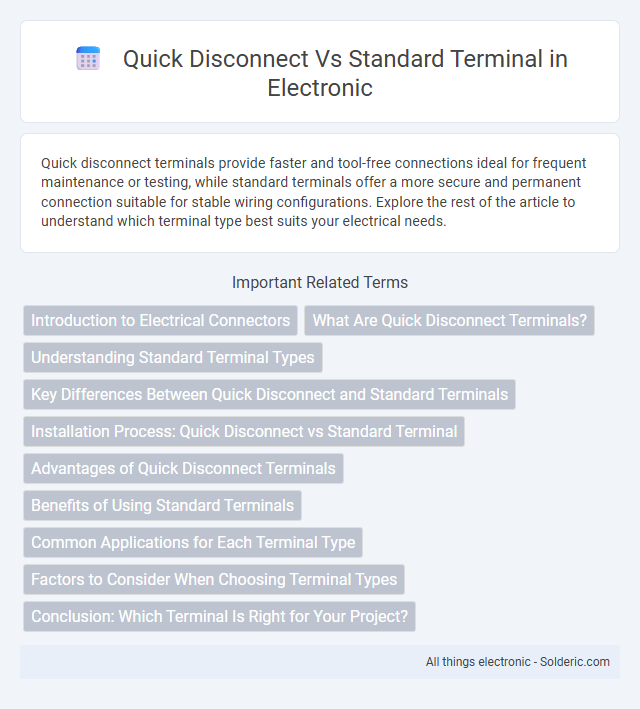Quick disconnect terminals provide faster and tool-free connections ideal for frequent maintenance or testing, while standard terminals offer a more secure and permanent connection suitable for stable wiring configurations. Explore the rest of the article to understand which terminal type best suits your electrical needs.
Comparison Table
| Feature | Quick Disconnect Terminal | Standard Terminal |
|---|---|---|
| Connection Type | Push-on/Pull-off snap connection | Screw or solder connection |
| Installation Speed | Fast and tool-free | Slower, requires tools |
| Reliability | Secure, vibration resistant | Strong mechanical hold |
| Reusability | Reusable multiple times | Reusable but may wear over time |
| Application | Ideal for quick maintenance and replacements | Used in permanent or semi-permanent installations |
| Cost | Generally higher per unit | More economical per unit |
| Common Materials | Copper, tin-plated steel | Copper, brass, tin-plated |
Introduction to Electrical Connectors
Quick disconnect terminals offer faster installation and removal compared to standard terminals, enhancing efficiency in electrical connections. Their design allows for secure, tool-free engagement, reducing the risk of loose connections and improving maintenance convenience. Choosing the right connector ensures your electrical system operates reliably and safely under various conditions.
What Are Quick Disconnect Terminals?
Quick disconnect terminals are electrical connectors designed for rapid and easy connection or disconnection without the need for tools, commonly used in automotive, appliance, and industrial wiring applications. They consist of a male tab and a female receptacle that securely snap together, providing reliable electrical contact and mechanical retention. Compared to standard terminals, which often require screws or soldering, quick disconnect terminals significantly reduce assembly time and improve maintenance efficiency.
Understanding Standard Terminal Types
Standard terminal types primarily include blade, spade, ring, and fork terminals, each designed for specific wire-to-device connections. Blade terminals provide a flat, rectangular contact surface, often used in automotive and industrial applications, while spade terminals offer easy installation and removal with forked ends. Ring and fork terminals secure wires to screws or posts, with ring terminals providing a closed loop for reliable fastening and fork terminals allowing quick attachment without complete removal of the screw.
Key Differences Between Quick Disconnect and Standard Terminals
Quick disconnect terminals enable rapid and tool-free connection or disconnection of wires, enhancing serviceability and reducing maintenance time. Standard terminals require screws or soldering for securing wires, providing a more permanent and vibration-resistant connection. The key differences lie in ease of installation, speed of wire termination, and suitability for applications requiring frequent disconnects versus permanent connections.
Installation Process: Quick Disconnect vs Standard Terminal
Quick disconnect terminals offer a faster and more efficient installation process, allowing wires to be connected or disconnected without tools, which reduces downtime and maintenance effort. Standard terminals typically require screws or soldering for secure attachment, demanding more time and precision during installation. Choosing quick disconnects enhances workflow in applications requiring frequent disassembly or repairs, while standard terminals provide a more permanent, stable connection.
Advantages of Quick Disconnect Terminals
Quick disconnect terminals offer significant time-saving advantages by enabling fast and tool-free connections and disconnections, which enhances maintenance efficiency. Their design ensures secure, reliable electrical contacts that reduce the risk of loose connections and electrical failures. You benefit from improved safety and convenience, making them ideal for applications requiring frequent wiring changes or troubleshooting.
Benefits of Using Standard Terminals
Standard terminals provide a reliable and cost-effective solution for electrical connections, ensuring secure and consistent conductivity in various applications. Their compatibility with a wide range of wire sizes and connectors simplifies installation and maintenance processes. Enhanced durability under vibration and environmental stress makes standard terminals suitable for automotive, industrial, and household wiring projects.
Common Applications for Each Terminal Type
Quick disconnect terminals are commonly used in automotive wiring, household appliances, and electronic equipment for fast and secure connections that allow easy maintenance and replacement. Standard terminals are preferred in industrial machinery and electrical panels where permanent, robust connections ensure consistent electrical conductivity and resistance to vibration. Your choice depends on whether you prioritize rapid disconnection or durable, long-term reliability in the application.
Factors to Consider When Choosing Terminal Types
Choosing between quick disconnect and standard terminals depends on factors such as ease of installation, maintenance requirements, and application environment. Quick disconnect terminals offer fast, tool-free connections ideal for frequent disassembly, while standard terminals provide more secure, permanent connections suitable for high-vibration or high-current applications. Material compatibility, current rating, and environmental exposure also influence the optimal terminal choice for electrical systems.
Conclusion: Which Terminal Is Right for Your Project?
Quick disconnect terminals offer fast, tool-free connections ideal for projects requiring frequent assembly or maintenance, while standard terminals provide a more secure, permanent connection suited for high-vibration or heavy-duty applications. Your choice depends on whether ease of use and flexibility or robust, long-lasting connections are paramount for your project's success. Consider the electrical load, environmental conditions, and maintenance needs to determine the optimal terminal type.
Quick disconnect vs Standard terminal Infographic

 solderic.com
solderic.com